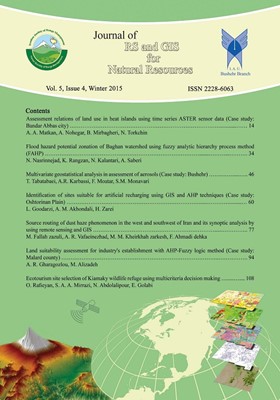Assessment relations of land use in heat islands using time series ASTER sensor data (Case study: Bandar Abbas city)
Subject Areas : Geospatial systems developmentAli aKbar Matkan 1 , Ahmad Nohegar 2 , Babak Mirbagheri 3 , Nahid Torkchin 4
1 - Assoc. Prof. Department of Remote sensing and Geographic Information Science, Shahid Beheshti University
2 - Assoc. Prof. Department of Natural Resources, Hormozgan University
3 - Lecturer Department of Remote sensing and Geographic Information Science, Shahid Beheshti University
4 - MSc. Student of Remote sensing and Geographic Information Science, Hormozgan University
Keywords:
Abstract :
Investigation of the situation of heat radiation scattering and its relationship by land use types is important in identification of the urban microclimate. Temperature is one of the features that are influenced by environmental conditions and it is considered as one of quality indices of environmental. According to this study the quality of the environment and the amount of pressure on which come to attention. On the other hand, land use planning as the main core of the urban planning based understanding of the environment is searching to find a way to improvement of environmental, social and ecological system of cities to the aims of sustainable development, especially countries. In this study, the effects of land use/cover and risk of land surface temperature (LST) in the coastal city of Bandar Abbas assessed by using satellite imaging data Terra ASTER for the years 2007 and 2011. After the processing required and using the heat equation, the surface temperature was prepared. Land use layers and harvesting of selected parts and also inferential statistical tests (Kruskal-Wallis test and Spearman correlation coefficient) the relation between land use/cover and surface temperature was calculated. The results showed industrial areas, barren land of high temperature and high coastal areas due to the presence of water due to evaporation and transpiration from vegetation green leaf area of trees and shade temperatures were lower than those of other users.


